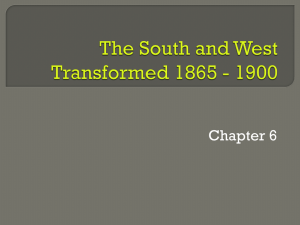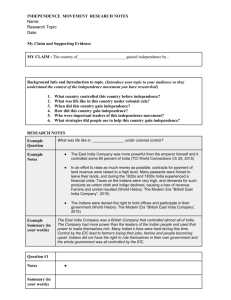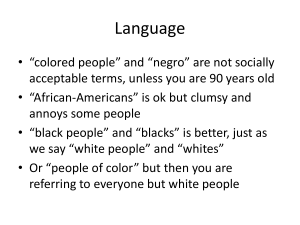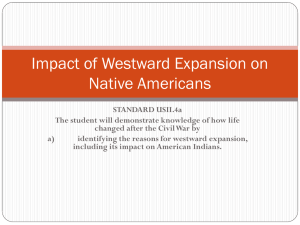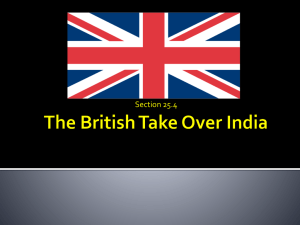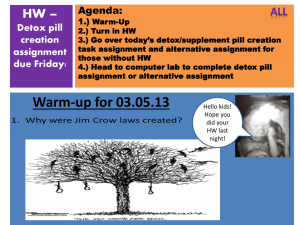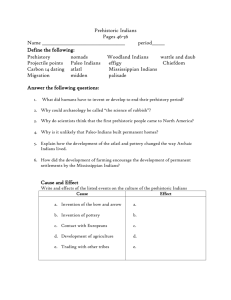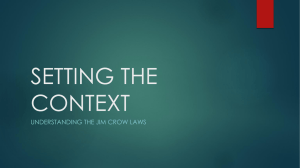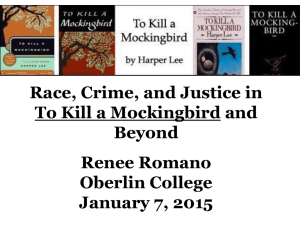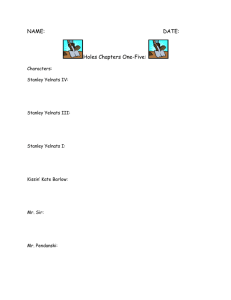Holes Social Studies Project
advertisement
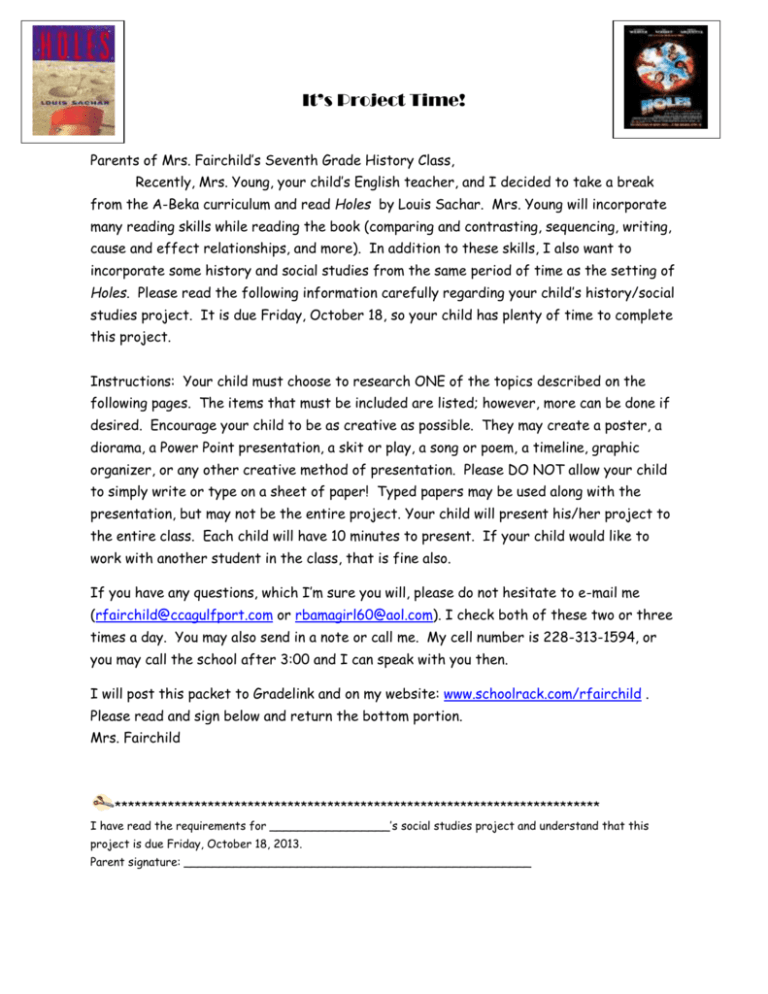
It’s Project Time! Parents of Mrs. Fairchild’s Seventh Grade History Class, Recently, Mrs. Young, your child’s English teacher, and I decided to take a break from the A-Beka curriculum and read Holes by Louis Sachar. Mrs. Young will incorporate many reading skills while reading the book (comparing and contrasting, sequencing, writing, cause and effect relationships, and more). In addition to these skills, I also want to incorporate some history and social studies from the same period of time as the setting of Holes. Please read the following information carefully regarding your child’s history/social studies project. It is due Friday, October 18, so your child has plenty of time to complete this project. Instructions: Your child must choose to research ONE of the topics described on the following pages. The items that must be included are listed; however, more can be done if desired. Encourage your child to be as creative as possible. They may create a poster, a diorama, a Power Point presentation, a skit or play, a song or poem, a timeline, graphic organizer, or any other creative method of presentation. Please DO NOT allow your child to simply write or type on a sheet of paper! Typed papers may be used along with the presentation, but may not be the entire project. Your child will present his/her project to the entire class. Each child will have 10 minutes to present. If your child would like to work with another student in the class, that is fine also. If you have any questions, which I’m sure you will, please do not hesitate to e-mail me (rfairchild@ccagulfport.com or rbamagirl60@aol.com). I check both of these two or three times a day. You may also send in a note or call me. My cell number is 228-313-1594, or you may call the school after 3:00 and I can speak with you then. I will post this packet to Gradelink and on my website: www.schoolrack.com/rfairchild . Please read and sign below and return the bottom portion. Mrs. Fairchild ************************************************************************* I have read the requirements for _________________’s social studies project and understand that this project is due Friday, October 18, 2013. Parent signature: _________________________________________________ Topic 1: Chief Joseph’s Words of Surrender Objectives: • To understand United States Westward Expansion and how it affected relations with American Indians • To reflect on the American Indian experience(s) of Westward Expansion Introduction: Stanley Yelnats’ great-grandfather, Stanley Yelnats I (son of the no-good dirty-rotten-pig-stealer) loses his fortune while attempting to move west from New York to California. His journey is cut short when his stagecoach is robbed by Kissing Kate, so Stanley settles in Texas instead of California. Stanley Yelnats’ journey west was typical of the 1800s, the period of Westward Expansion in the United States. Westward Expansion was a time when many people envisioned the western United States as a land of opportunity and prosperity with the possibility of even finding gold. It was a time of pioneer heroism, adventure, and outlaws. Westward Expansion also resulted in a time of great loss for American Indians, who were driven from their land and forced to live on designated parcels of land called reservations. Background information: These were the motivating factors for Westward Expansion – wealth, land, and adventure. Ranchers, farmers, merchants, and miners, among others, made the move west. During the 1840s, the United States acquired Texas, California, and the Southwest. After the U.S. Civil War in the 1860s, the migration west accelerated, and the U.S. Army focused its military resources in that direction as well. As more and more whites settled in the West, the U.S.government demanded that the American Indians move to reservations, removing tribes from land rich in gold, silver, timber, oil, and farmland. On the reservations, American Indians were forced to live by the whites’ laws and customs, and to speak English. Some American Indian tribes fought to maintain their tribal integrity and independence, and they resisted being forced onto reservation land. The Cheyenne, Sioux, Comanche, Kiowa, Apache, Arapaho, and Nez Percé were some of the tribes who fought the most dramatically to resist reservation life. After several broken promises from the whites, the Nez Percé, who lived where the states of Oregon, Idaho, and Washington now come together, attempted to flee the United States to Canada. U.S. soldiers caught up with the Nez Percé just a few miles short of the Canadian border and battles ensued. After several of his people were killed, Nez Percé leader Chief Joseph surrendered and the Nez Percé were relocated to reservation land. Assignment: Read Chief Joseph’s famous surrender speech below. Think about Chief Joseph’s words and answer these questions or incorporate them into your project: 1. What reasons does he give for surrendering? 2. Compare the effect of his language and choice of words to the simple statement, “I surrender.” Discuss whether surrendering can be a more courageous act than continuing to fight. 3. Identify at least 3 people in the background information or Chief Joseph’s speech. 4. Write a paragraph expressing your thoughts and feelings about surrender and courage. Can surrendering be more courageous than continuing a fight? Why or why not? 5. Include an example from your own life when you either chose to surrender rather than fight, or when you wished you had surrendered instead of fighting, or vice versa. How could the outcome of the situation have changed? “I am tired of fighting. Our chiefs are killed. Looking Glass is dead. Toohulhulsote is dead. The old men are all dead. It is the young men who say yes or no. He who led the young men is dead. It is cold and we have no blankets. The little children are freezing to death. My people, some of them, have run away to the hills, and have no blankets, no food; no one knows where they are – perhaps freezing to death. I want to have time to look for my children and see how many of them I can find. Maybe I shall find them among the dead. Hear me, my chiefs, I am tired; my heart is sick and sad. From where the sun now stands I will fight no more forever.” – Chief Joseph Topic 2: Digging up Facts about American Legends Objectives: To understand the literary meaning of legend To conduct research about American legends Introduction: In Holes, the author weaves the story around the legend of the fictional character, Kissing Kate Barlow, a schoolteacher-turned-outlaw in the American West. A legend is a story passed down from generation to generation. Legends are often historical in nature, but not verifiable. They often include exaggerations, embellishments, and a slight bending of the truth. Davy Crockett, Daniel Boone, and Annie Oakley are Western figures whose life stories have been converted to legend in the popular imagination. Assignment: Choose one of the following Western figures. Using designated web sites and/or other resources, complete the following graphic organizer and separate fact from fiction about a real Western legend. 1. Choose one figure to research: Davy Crockett, Daniel Boone, Johnny Appleseed, Wild Bill Hickok, Kit Carson, Calamity Jane, Buffalo Bill, Jesse James, Billy the Kid, Wyatt Earp, Belle Starr, Doc Holliday, Butch Cassidy, Annie Oakley, or any other legendary figure from the Wild West (1800s). See the last two websites below for a complete list. 2. Research the following questions: Where was the person born? What was their childhood like? What did the person do as an adult? What are they most famous for? Did they have any memorable quotes or sayings? 3. Why did you choose this character? 4. Are there any character traits that you have in common with your character? If so, what are they? 5. What did your person do that you would like to do or not do? 6. What is one thing that you learned about this person that you didn’t already know? 7. Are there any “tall tales” about this person that are not really true? If so, name at least one of them. Resources: Free Internet encyclopedia with information on all three legends: www.encyclopedia.com Hosted by MSN, students can search the database in the Encyclopedia Center: www.encarta.com The History Channel web site offers information on all three legends: www.historychannel.com eHistory provides information on Daniel Boone: www.ehistory.com Britannica.com is a fee-for-service online encyclopedia: www.britannica.com You may also use Wikipedia, but keep in mind that this is NOT the most reliable website: http://www.wikipedia.org/ http://www.sjgames.com/gurps/Roleplayer/Roleplayer25/OldWest-Characters.html http://www.rankopedia.com/Greatest-Legendary-Figure-of-the-American-Wild-West/Step1/5564/.htm You may also use other sources. Topic 3: Jim Crow Laws and the American South OBJECTIVE: • To gain a basic understanding of the Civil Rights movement, historical antecedents, key figures, events, and issues Introduction and Background Information: In Holes, the people of Green Lake are uncomfortable and even hostile toward the affections shared between Miss Katherine and Sam, the Onion Man. In Green Lake, it is against the law for a black man to kiss a white woman. Such attitudes and laws were not uncommon in the late 1800s and even into the mid-1900s. Although the Thirteenth Amendment to the Constitution freed blacks from slavery in 1865, blacks and whites remained largely segregated. In the southern states especially, legislation known as Jim Crow laws were passed to legalize segregation. These laws created separate areas for blacks and whites in public waiting rooms, restaurants, schools, and hospitals. The name Jim Crow comes from a popular minstrel song, Jump, Jim Crow. The word “minstrel” refers to performers, typically white men, who put black paint on their faces to mimic blacks. These performers sang, danced, and acted happy and simple in an effort to make fun of black people. Jim Crow laws were in effect until the 1960s when segregation became illegal in the United States. Assignment: 1. 2. 3. 4. 5. 6. Read excerpts from Holes that relate to race and segregation to better understand the events that led up to the Civil Rights movement. Try starting with chapters 25 (p. 109) and 26 (p. 114). Share with the class what you read. Be familiar with the meaning of the phrase “Civil Rights movement.” The phrase commonly refers to a period in the 1950s and 1960s when a number of organizations and individuals, black and white, successfully challenged legal segregation of the races. Using the attached graphic organizer, research the four topics about the Civil Rights movement and record them in the appropriate spaces. Find out exactly where the name “Jim Crow” came from. Was Jim Crow a real person? Discuss the term “Jim Crow.” What is particularly demeaning and hurtful about the term? How does the term stereotype black Americans? Write a paragraph about why you think the source of the term, in the song Jump, Jim Crow, is insulting to blacks. Find the lyrics to the song “Jump, Jim Crow” on the internet, or read the words below. Use some of the lyrics in a creative way in your presentation. Standard English form of “Jump, Jim Crow”: Come, listen, all you girls and boys, I'm just from Tuckahoe; I'm going to sing a little song, My name's Jim Crow. Chorus: Wheel about, and turn about, and do just so; Every time I wheel about, I jump Jim Crow. I went down to the river, I didn't mean to stay, But there I saw so many girls, I couldn't get away. I'm roaring on the fiddle, and down in old Virginia, They say I play the scientific, like master Paganini, I cut so many monkey shines, I dance the galoppade; And when I'm done, I rest my head, on shovel, hoe or spade. I met Miss Dina Scrub one day, I give her such a buss [kiss]; And then she turn and slap my face, and make a mighty fuss. The other girls they begin to fight, I told them wait a bit; I'd have them all, just one by one, as I thought fit. I whip the lion of the west, I eat the alligator; I put more water in my mouth, then boil ten loads of potatoes. The way they bake the hoe cake, Virginia never tire; They put the dough upon the foot, and stick them in the firewagon Topic 4: Westward Expansion and the American Indian Experience Objectives: To understand United States Westward Expansion and how it affected relations with American Indians To reflect on the American Indian experience of Westward Expansion Description: Stanley’s great grandfather, Stanley Yelnats I (son of the no-good dirty-rotten pig stealer) lost his fortune while attempting to move west from New York to California. His journey was cut short when his stagecoach was robbed by Kissing Kate, and Stanley settled in Texas instead of California. Stanley Yelnats’ journey west was typical of the 1800s, the period of Western Expansion in the United States. Westward Expansion was a time when many people envisioned the western United States as a land of opportunity and prosperity – even gold. It was a time of pioneer heroism, adventure, and outlaws. The period of Westward Expansion was also a time of great loss for American Indians who were driven from their land and forced to live on designated parcels of land called reservations. Background Information: These were the motivating factors for Westward Expansion – wealth, land, and adventure. Ranchers, farmers, merchants, and miners, among others, made the move west. During the 1840s, the United States acquired Texas, California, and the Southwest. After the U.S. Civil War in the 1860’s, the migration west accelerated, and the U.S. Army focused its military resources in that direction as well. As more and more whites settled in the west, the United States government demanded that American Indians move to reservations, removing tribes from land rich in gold, silver, timber, and oil. On the reservations, American Indians were forced to live by the whites’ laws and customs, and to speak English. Some American Indian tribes fought to maintain their tribal integrity and independence and resisted being forced onto reservation land. The Cheyenne, Sioux, Comanche, Kiowa, Apache, Arapaho and Nez Percé were some of the tribes who fought the most dramatically to resist reservation life. Assignment: 1. Here are some of the reasons for putting American Indians on reservations, some of which we would now classify as blatantly racist, including: • To teach American Indians to farm and “value” property • To “civilize” American Indians through education • To teach American Indians English • To remove “obstacles” to the exploitation of natural resources • To keep settlers safe from “savage” attacks • To ensure separate living space and reduce chances of “interbreeding” Choose 2 of the statements listed above to include in your presentation. How do you feel about these statements? Was it fair for the American Indians to be treated this way? Why or why not? 2. Be able to discuss why American Indians might have resisted moving to reservation land, and why they might not have wanted to live by the whites’ rules and customs. Why might the whites’ goals for American Indians have been offensive to the American Indians? 3. Some American Indians agreed to live on reservations, but what options were there for those American Indians who did not want to live on reservations? Research and give two choices they might have had. 4. Choose one of the following topics to research and include in your presentation. Suggested research topics: Geronimo, Sitting Bull, Crazy Horse, Trail of Tears, Wounded Knee Massacre, Battle of Little Big Horn, Ghost Dance religion, and any American Indian tribe. 5. Find out where the nearest Indian reservation (to Gulfport) is located.
